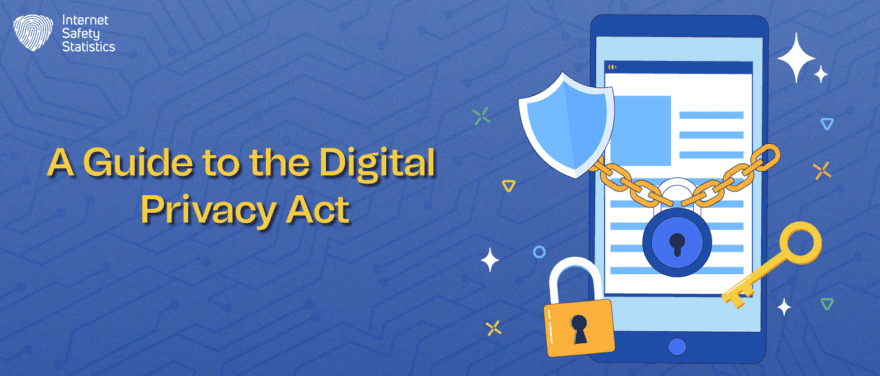
Due to our constant online connectivity, concerns surrounding individual data privacy and corporate data collection practices have reached a critical juncture. This has led to the emergence of various legislative initiatives, including the Digital Privacy Act, aimed at regulating the use and protection of personal information in the digital realm.
This article tackles the core principles and potential implications of the Digital Privacy Act, examining its intended effects on individuals, businesses, and the broader digital landscape. We will analyse the Act’s key provisions, exploring how it seeks to empower individuals with greater control over their data and ensure responsible data handling by organisations.
An Introduction to the Digital Privacy Act
The vast amount of information generated through online interactions has fueled anxieties about data breaches, targeted advertising, and potential misuse by corporations and governments. In response to these growing concerns, several regions and countries have implemented Digital Privacy Acts (DPAs) legislative frameworks to establish clear guidelines and data protection for individuals in the digital sphere.
What Are the Objectives of DPAs?
- Empowering individuals: By granting individuals greater control over their personal data, the Act seeks to equip them with the tools to understand, access, and manage their digital footprint. This typically involves provisions like transparency requirements for data collection and usage, the right to access and rectify personal information, and, in some cases, the right to request data erasure or restrict its processing.
- Holding organisations accountable: The Act imposes obligations on organisations that handle personal data. These obligations often include data minimisation principles, requiring organisations to limit data collection to what’s necessary for specific purposes. Additionally, the Act mandates appropriate security measures to protect data from unauthorised access, loss, or misuse. Furthermore, reporting procedures for data breaches and mechanisms for addressing individual inquiries are often established.
- Building trust and confidence: Ultimately, the Digital Privacy Act aims to foster a more trustworthy and accountable digital environment. By granting individuals greater control and ensuring responsible data practices by organisations, the Act strives to create a landscape where individuals can participate in the digital world with greater confidence and knowledge of their rights.
Key Provisions of the Digital Privacy Act
1. Data Collection and Usage Limitations: The DPA seeks to minimise the amount of personal data collected by organisations. This often involves:
- Purpose limitation: Organisations can only collect and process data for specific, legitimate purposes clearly communicated to individuals.
- Data minimisation: Organisations must limit the data collected to what is necessary and relevant for the stated purpose.
- Storage limitations: Individuals may have the right to request retention periods for their data and its subsequent deletion.
2. User Consent Requirements for Data Processing: The DPA typically requires organisations to obtain clear and informed consent from individuals before handling their personal data. This consent should be:
- Freely given: Individuals should not be pressured or forced to consent.
- Specific: Consent should be granted for specific purposes and types of data processing.
- Informed: Individuals should be clearly informed about how their data will be used before they consent.
- Withdrawable: Individuals should have the right to withdraw their consent at any time.
3. Right to Access, Rectify, and Erase Personal Data: Individuals have the right to:
- Access their personal data: This includes requesting and receiving copies of their data held by organisations.
- Rectify inaccurate or incomplete data: Individuals can request corrections to ensure their data is accurate and up-to-date.
- Erase their personal data under certain circumstances: This may include the right to be forgotten after a specific period or if the data is no longer necessary for its original purpose.
4. Data Breach Notification Procedures: In the event of a data breach, organisations are obligated to:
- Promptly notify affected individuals: This ensures individuals can take immediate actions to protect themselves from potential harm.
- Report the breach to relevant authorities: This helps facilitate investigations and hold organisations accountable.
- Implement measures to mitigate the breach: Organisations must take appropriate steps to prevent further harm and discuss the vulnerabilities that led to the breach.
5. Enforcement Mechanisms and Penalties: The DPA establishes mechanisms for enforcing its provisions and holding organisations accountable for non-compliance. These may include:
- Regulatory oversight and investigations: Regulatory bodies may investigate potential violations and take enforcement actions.
- Administrative fines and penalties: Non-compliant organisations may face financial repercussions based on the severity of the breach.
- Civil lawsuits: Individuals may be able to bring legal action against organisations for violations of the DPA.
These key provisions represent a core framework for individual data protection within the DPA. However, the specific details and emphasis of each provision can vary depending on the region or country where the Act is implemented.

Impact and Implications of the Digital Privacy Act
The Digital Privacy Act (DPA) has the potential to impact individuals and society in numerous ways significantly. Let’s analyse some of its potential benefits:
Increased Control over Personal Data
- Transparency Reports: The DPA often mandates organisations to publish regular transparency reports detailing the types of personal data collected, the purposes for its use, and the entities it’s shared with. This empowers individuals to take informed decisions about their online activities.
- GDPR Study: A 2023 study by the European Commission found that 72% of EU citizens felt more in control of their personal data after the implementation of the General Data Protection Regulation (GDPR), a similar privacy law.
- Data Portability: Under the DPA, individuals can typically request their personal data in a readily-transferable format. This enables them to switch between service providers or platforms without data silos easily.
Reduced Risk of Misuse and Profiling:
- Data Minimisation: By limiting the data organisations can collect and process, the DPA reduces the potential for misuse or profiling based on extensive personal information.
- Breach Notification: Mandatory data breach notification procedures under the DPA ensure individuals are promptly informed of potential security risks, allowing them to take necessary steps to mitigate harm related to data protection and digital information.
- Targeted Advertising Reduction: A 2020 study by the University of California, Berkeley, found that users who exercised their “Do Not Track” rights under the California Consumer Privacy Act (CCPA), another similar law, saw a 51% reduction in targeted advertising across various platforms.
Building Trust in Online Platforms and Services:
- Reputation Boost: Studies have shown that companies demonstrating strong data privacy practices often experience improved brand reputation and customer loyalty.
- Innovation Driver: The DPA can incentivise organisations to develop innovative solutions for secure data handling and user privacy under the Digital Services Act, fostering a more trustworthy and ethical digital ecosystem.
- Global Reach: As privacy laws like the DPA gain traction worldwide, international cooperation and harmonisation efforts can enhance global trust in online platforms and services.
Challenges Facing the Implementation of DPAs
1. Striking a Balance: Implementing the DPA effectively requires careful consideration of competing interests. This includes ensuring adequate protection for individual privacy while not unduly hindering legitimate business activities or compromising broader public welfare concerns. Finding the right balance is a daunting task that requires ongoing evaluation and adaptation.
2. Adapting to Technological Advancements: The rapid pace of technological change in data collection and processing methods poses a challenge for the DPA. To remain effective, the Act needs to be regularly reviewed and updated to address new technologies and ensure it can adequately protect individuals in the evolving digital landscape.
3. International Coordination: In a globalised world where data often crosses borders, addressing data privacy concerns effectively requires international cooperation and harmonisation. Different legal frameworks and enforcement approaches across regions can hinder the DPA’s reach and effectiveness. Establishing consistent standards and frameworks for data protection remains a complex and ongoing challenge.
Data Security and Breach Management: Protecting Personal Information

1. Identifying Potential Breaches: Organisations must implement robust security measures to detect and prevent data breaches. This includes regularly monitoring systems for suspicious activity, analysing logs, and utilising intrusion detection technologies. Additionally, clear protocols for reporting potential breaches by employees or external sources are crucial for timely response.
2. Importance of Safeguarding Personal Data: Organisations are responsible for protecting the personal information they collect and store. This involves employing appropriate security measures commensurate with the sensitivity of the data and the potential harm caused by a breach. Failure to adequately safeguard data can result in legal repercussions, reputational damage, and financial losses.
3. Responding to Data Breaches: In the event of a data breach, organisations must respond swiftly and effectively to mitigate harm and comply with legal requirements. This typically involves:
- Containment: Taking immediate action to stop the breach and secure affected systems.
- Investigation: Determining the severity of the breach and identifying the source of the vulnerability.
- Notification: Informing affected individuals and relevant authorities as required by law.
- Remediation: Addressing the vulnerability and implementing measures to prevent future breaches.
4. Legal Implications: Several laws and regulations, like the Personal Information Protection and Electronic Documents Act (PIPEDA) in Canada, govern the collection, use, and disclosure of personal information by organisations. These laws often stipulate data breach notification requirements, penalties for non-compliance, and individual rights regarding their personal information.
5. Roles and Responsibilities: Clearly defined roles and responsibilities in case of a data breach are critical for a coordinated and effective response. This often involves:
- Incident Response Team: A dedicated team with expertise in cybersecurity and data breach management responsible for handling the response.
- Senior Management: Providing resources and oversight for the incident response process.
- Legal Counsel: Ensuring compliance with legal requirements and advising on potential liabilities.
- Public Relations: Managing communication with stakeholders and media.
The Digital Privacy Act serves as a starting point, not a definitive solution. Its effectiveness hinges on continuous dialogue and adaptation. As technology evolves and societal needs shift, the Act must be regularly reviewed and updated to remain relevant and effective. Stakeholders from individuals and organisations to policymakers and technologists must engage in collaborative efforts to ensure the Act serves its intended purpose: protecting individual privacy in the dynamic digital landscape.
FAQs
What is GDPR?
The General Data Protection Regulation (GDPR) is a legal regime in the European Union (EU) that applies rules for how organisations must collect, use, and protect personal data. It aims to give individuals more control over their personal information and to simplify the regulation of data privacy laws across the EU.
What counts as a data breach?
Data breaches often involve unauthorised access, loss of control, and exposure of sensitive personal data. The harm potential, volume of data affected, and compliance with notification laws further determine if an incident qualifies as a breach.
What happens if you breach the Data Protection Act?
If you breach the UK Data Protection Act, the ICO can investigate, issue corrective orders, impose hefty fines, publicly register the breach, or even pursue criminal charges. To avoid these consequences, prioritise data security measures, staff training, and a data breach response plan.
What countries are subject to GDPR?
The General Data Protection Regulation (GDPR) applies basically to all member states of the European Union (EU), a total of 27 countries.
